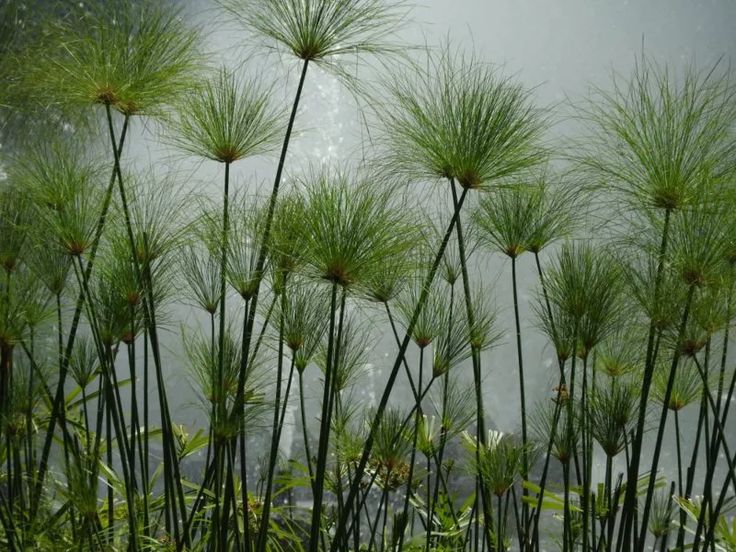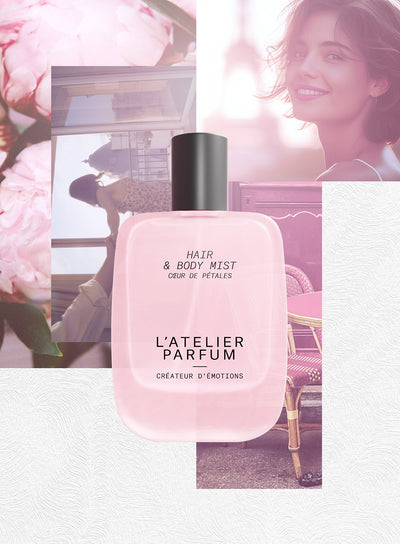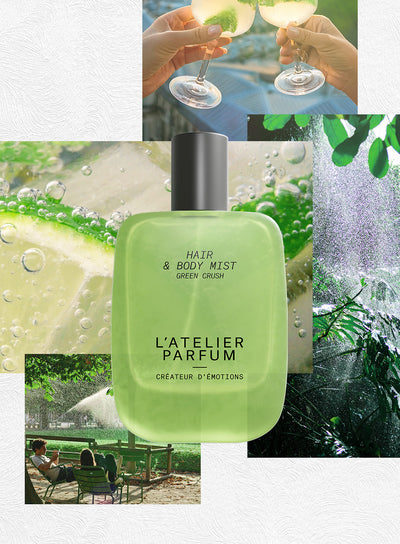Papyrus: a timeless and refined aroma

In the collective imagination, papyrus symbolizes pharaonic mysteries, sacred manuscripts, and Africa’s forgotten rituals. But Cyperus papyrus is not just a botanical relic from the past. For several decades now, it has established itself as an emblematic raw material in contemporary perfumery, evoking depth, elegance, and rootedness. Let’s explore together the journey of this mythical plant, from its glorious history on the banks of the Nile to the extreme sophistication of Haute Parfumerie, via the expertise of exceptional houses like Robertet.
Botanical Origin: Cyperus papyrus, Between Marshland and Memory
Papyrus belongs to the Cyperaceae family. This perennial herb can reach up to five meters in height. It develops a powerful triangular stem adorned with spectacular inflorescences reminiscent of a botanical crown. Papyrus thrives in the deltas and marshes of North and East Africa, from Sudan to Ethiopia, but also around Lake Victoria and the eastern Mediterranean shores. Capable of surviving regular flooding, it anchors itself in muddy, mineral-rich soils—a testament to its adaptation to birth and transmission—it was humanity’s very first “paper.”
History of Papyrus: Manuscripts, Rituals, and Fragrance
Since Ancient Egyptian times, papyrus has been at the heart of local culture and economy. It was the noble material for the earliest manuscripts, symbolizing knowledge, life, and eternity. It can be found in tombs and temples, where it stands in offerings to the gods. Yet its uses did not end there: stems and rhizomes were sometimes crushed, boiled, or infused to create sacred ointments and incense, enveloping religious ceremonies and processions with their scent.
However, its introduction into Western perfumery is quite recent. For a long time kept confidential, the papyrus note emerged on the international scene starting in the 1980s—first as a woody base, sometimes substituting for materials like vetiver or cedar, then as a mineral, rooty, and elegant signature, highly prized in modern niche perfumery.
Cultivating Papyrus: Rarity, Preservation, and Contemporary Challenges
Papyrus cultivation is delicate. Once abundant along the Nile, the plant now suffers from river regulation and overexploitation: the species has often declined due to dam construction and the scarcity of wetlands. Still, papyrus continues to flourish in certain marshes in Chad, Uganda, or Sudan, but wild harvesting must be strictly regulated to preserve biodiversity and natural regeneration.
Replanting and sustainable management initiatives are emerging around Lake Victoria and other African regions, blending artisanal approaches (basket weaving, historical reconstitution) with production destined for high-end perfumery. Thanks to its rapid growth cycle, papyrus—when cultivated thoughtfully—can be harvested responsibly, providing stems and rhizomes of beautiful olfactory quality.
The company Robertet, committed to natural and responsible perfumery, has developed sustainable supply chains for harvesting papyrus, forging strong partnerships with local communities, and coordinating cutting, replanting, and preservation to ensure continuity and traceability.
From Plant to Essence: The Work of a Craftsman
Obtaining pure, noble papyrus essence is a complex endeavor. Its aromatic compounds, with low volatility, require demanding extraction processes.
Main Techniques:
Papyrus Olfactory Profile: Signature, Mystery, Elegance
The magic of papyrus lies in its subtle profile:
This complexity makes it a favored base note, providing structure, sometimes replacing or complementing vetiver, patchouli, or cedar, while also adding a sacred, mysterious dimension. It brings balance, modernity, and poetic grounding to contemporary perfumes.
Effects on Mood: Rootedness and Spirituality
As deep as it is rare, the scent of papyrus exerts a powerful psychological effect:
Favored by lovers of discreet, mysterious, and refined perfumes, it cloaks the soul like an invisible, reassuring, and elegant mantle, conducive to grounding.
Robertet’s Expertise: From Earth to Soul
A leader in natural raw materials, Robertet is a pioneer in the valorization of papyrus. The house follows a Seed-to-Scent™ approach, ensuring quality and respect for the ecosystem:
Thanks to this expertise, Robertet provides perfumers with a unique essence, true to the plant—at once green, woody, dry, and spicy—far more complex than any synthetic reconstruction.
Botanical and Symbolic Anecdotes: The World’s Living Archive Plant
Papyrus is much more than an aroma—it embodies humanity’s written memory:
Used for basketry, boats, furniture, and then in fragrance, it has traversed the centuries, demonstrating humanity’s ability to sublimate nature.
Papyrus in Olfactory Psychology: A Song of Anchoring
Recent studies highlight the role of woods and mosses in emotional well-being. Like pine or cedar, papyrus encourages rootedness, stability, and self-confidence. Its scent evokes deep forests, the sacred calm of libraries—universes perfect for meditation or creativity.
Many houses, including Robertet, are now studying the psychological impact of raw materials: a fragrance containing papyrus supports concentration, channels stress, and evokes the golden light of Egyptian temples.
Techniques and Innovations: A Challenge for Green Perfumery
Environmental responsibility is a core focus for today’s perfume houses. Papyrus presents a dual challenge: preserving the natural resource in its habitat while ensuring a complex and faithful aroma in the bottle. In this context, pioneers like Robertet combine eco-responsible approaches, advanced extraction methods, and the development of fair-trade supply chains, offering a traceable, certified, and authentic essence that stands out in the demanding world of Haute Parfumerie.
Iconic Perfumes Featuring Papyrus
Though long discreet, papyrus has been incorporated into several major modern perfumery creations, appreciated for their mystery and elegance:
Timbuktu, L’Artisan Parfumeur - 2004 : Aromatic woody
Oud Silk Mood, Maison Francis Kurkdjian - 2013: Floral–oriental
Papyrus Moléculaire, Maison Crivelli - 2020: Floral–woody
Private Label, Jovoy - 2011: Oriental
Santal 33, Le Labo - 2011 : Aromatic woody
Baudelaire, Byredo - 2009: Oriental woody
Encens Papyrus, La Belle Mèche - 2020: Incense–woody
Each time, the papyrus note acts as a backbone, providing depth and greatness; it structures, unifies, and enhances without ever overpowering.
Papyrus at L’Atelier Parfum: The Living Memory of the Material
If Verte Euphorie , the fresh and vibrant fragrance from L’Atelier Parfum, celebrates the alliance of citrus and herbal notes, papyrus subtly infuses it with a sophisticated, woody nuance—both discreet and unforgettable. Paired with grapefruit, it reveals a fresh, green facet reminiscent of dawn over rice fields, while also providing a rare base of grounding and elegance.
Conclusion
Rare, mysterious, and precious, papyrus is the raw material of civilizations—and the perfumery of the future. Its olfactory complexity, millennial history, and evocative power make it a major ingredient—a voice for the earth, memory, and refined elegance. In contemporary trails, it becomes a signature, imprint, and living poetry.
Thanks to the expertise of houses like Robertet, papyrus transcends its status as a botanical relic to become a modern breath, a living memory, and an inexhaustible source of inspiration for anyone who dreams of anchored, subtle, and powerful fragrances.
Primary Sources:
Fragrantica : Papyrus
Perfume Society – Papyrus, ingredient profile
Osmoz – Encyclopédie du Papyrus
Botanical Origin: Cyperus papyrus, Between Marshland and Memory
Papyrus belongs to the Cyperaceae family. This perennial herb can reach up to five meters in height. It develops a powerful triangular stem adorned with spectacular inflorescences reminiscent of a botanical crown. Papyrus thrives in the deltas and marshes of North and East Africa, from Sudan to Ethiopia, but also around Lake Victoria and the eastern Mediterranean shores. Capable of surviving regular flooding, it anchors itself in muddy, mineral-rich soils—a testament to its adaptation to birth and transmission—it was humanity’s very first “paper.”
History of Papyrus: Manuscripts, Rituals, and Fragrance
Since Ancient Egyptian times, papyrus has been at the heart of local culture and economy. It was the noble material for the earliest manuscripts, symbolizing knowledge, life, and eternity. It can be found in tombs and temples, where it stands in offerings to the gods. Yet its uses did not end there: stems and rhizomes were sometimes crushed, boiled, or infused to create sacred ointments and incense, enveloping religious ceremonies and processions with their scent.
However, its introduction into Western perfumery is quite recent. For a long time kept confidential, the papyrus note emerged on the international scene starting in the 1980s—first as a woody base, sometimes substituting for materials like vetiver or cedar, then as a mineral, rooty, and elegant signature, highly prized in modern niche perfumery.
Cultivating Papyrus: Rarity, Preservation, and Contemporary Challenges
Papyrus cultivation is delicate. Once abundant along the Nile, the plant now suffers from river regulation and overexploitation: the species has often declined due to dam construction and the scarcity of wetlands. Still, papyrus continues to flourish in certain marshes in Chad, Uganda, or Sudan, but wild harvesting must be strictly regulated to preserve biodiversity and natural regeneration.
Replanting and sustainable management initiatives are emerging around Lake Victoria and other African regions, blending artisanal approaches (basket weaving, historical reconstitution) with production destined for high-end perfumery. Thanks to its rapid growth cycle, papyrus—when cultivated thoughtfully—can be harvested responsibly, providing stems and rhizomes of beautiful olfactory quality.
The company Robertet, committed to natural and responsible perfumery, has developed sustainable supply chains for harvesting papyrus, forging strong partnerships with local communities, and coordinating cutting, replanting, and preservation to ensure continuity and traceability.
From Plant to Essence: The Work of a Craftsman
Obtaining pure, noble papyrus essence is a complex endeavor. Its aromatic compounds, with low volatility, require demanding extraction processes.
Main Techniques:
- Steam Distillation: Used to obtain the essence from mature stems and rhizomes, this method naturally produces low yields.
- Supercritical CO₂ Extraction: A cutting-edge technique that isolates the molecules most faithful to the original papyrus scent, yielding an essence with green, woody, even leathery facets—generally more expensive, but treasured in high perfumery.
- Accord Reconstruction: To compensate for the rarity or expense of extraction, many perfumers assemble similar notes (using cypriol, vetiver, cedar, incense), or use Cyperus scariosus (cypriol), a related species from India with a similar yet distinct aroma, to achieve a custom papyrus effect.
Papyrus Olfactory Profile: Signature, Mystery, Elegance
The magic of papyrus lies in its subtle profile:
- Woody and dry, reminiscent of sun-dried cedar or an old library
- Earthy and mineral, evoking humus, warm stone, sap, and dried marsh mud
- Smoky and resinous, with a subtle incense note but no heaviness
- Green and aromatic, sometimes peppery, with tones of rushes and dry grass
- Leathery and mineral, nearly animalic in certain extractions
This complexity makes it a favored base note, providing structure, sometimes replacing or complementing vetiver, patchouli, or cedar, while also adding a sacred, mysterious dimension. It brings balance, modernity, and poetic grounding to contemporary perfumes.
Effects on Mood: Rootedness and Spirituality
As deep as it is rare, the scent of papyrus exerts a powerful psychological effect:
- Soothing and focusing: Its woody, mineral nature invites calm, meditation, and introspection.
- A sensation of rootedness: It connects individuals to the earth, memories, and nature’s gentle strength.
- Mystical and introspective: It conjures secret libraries, ancient rituals, and the quest for meaning and memory.
Favored by lovers of discreet, mysterious, and refined perfumes, it cloaks the soul like an invisible, reassuring, and elegant mantle, conducive to grounding.
Robertet’s Expertise: From Earth to Soul
A leader in natural raw materials, Robertet is a pioneer in the valorization of papyrus. The house follows a Seed-to-Scent™ approach, ensuring quality and respect for the ecosystem:
- Terroir selection: Robertet identifies the best wetlands in India to ensure aromatic diversity and seasonal harmony.
- Manual harvesting: Priority is given to preserving mother plants, with cutting calendars that respect natural regeneration.
- Expert extraction: Molecular distillation, mastery of CO₂ supercritical extraction, pursuit of olfactory purity and fidelity to the original aroma.
- Social commitment: The Robertet papyrus supply chain guarantees sustainable income for over 2,500 people, working hand in hand with rural communities and forest authorities to assure the resource’s longevity.
Thanks to this expertise, Robertet provides perfumers with a unique essence, true to the plant—at once green, woody, dry, and spicy—far more complex than any synthetic reconstruction.
Botanical and Symbolic Anecdotes: The World’s Living Archive Plant
Papyrus is much more than an aroma—it embodies humanity’s written memory:
- The first treaties on medicine, poetry, science—all were written on papyrus.
- In Egyptian mythology, it is the symbol of Lower Egypt, fertility, and rebirth in the afterlife.
- The goddess Isis is often depicted holding a papyrus stem—a symbol of eternal protection.
Used for basketry, boats, furniture, and then in fragrance, it has traversed the centuries, demonstrating humanity’s ability to sublimate nature.
Papyrus in Olfactory Psychology: A Song of Anchoring
Recent studies highlight the role of woods and mosses in emotional well-being. Like pine or cedar, papyrus encourages rootedness, stability, and self-confidence. Its scent evokes deep forests, the sacred calm of libraries—universes perfect for meditation or creativity.
Many houses, including Robertet, are now studying the psychological impact of raw materials: a fragrance containing papyrus supports concentration, channels stress, and evokes the golden light of Egyptian temples.
Techniques and Innovations: A Challenge for Green Perfumery
Environmental responsibility is a core focus for today’s perfume houses. Papyrus presents a dual challenge: preserving the natural resource in its habitat while ensuring a complex and faithful aroma in the bottle. In this context, pioneers like Robertet combine eco-responsible approaches, advanced extraction methods, and the development of fair-trade supply chains, offering a traceable, certified, and authentic essence that stands out in the demanding world of Haute Parfumerie.
Iconic Perfumes Featuring Papyrus
Though long discreet, papyrus has been incorporated into several major modern perfumery creations, appreciated for their mystery and elegance:
Timbuktu, L’Artisan Parfumeur - 2004 : Aromatic woody
Oud Silk Mood, Maison Francis Kurkdjian - 2013: Floral–oriental
Papyrus Moléculaire, Maison Crivelli - 2020: Floral–woody
Private Label, Jovoy - 2011: Oriental
Santal 33, Le Labo - 2011 : Aromatic woody
Baudelaire, Byredo - 2009: Oriental woody
Encens Papyrus, La Belle Mèche - 2020: Incense–woody
Each time, the papyrus note acts as a backbone, providing depth and greatness; it structures, unifies, and enhances without ever overpowering.
Papyrus at L’Atelier Parfum: The Living Memory of the Material
If Verte Euphorie , the fresh and vibrant fragrance from L’Atelier Parfum, celebrates the alliance of citrus and herbal notes, papyrus subtly infuses it with a sophisticated, woody nuance—both discreet and unforgettable. Paired with grapefruit, it reveals a fresh, green facet reminiscent of dawn over rice fields, while also providing a rare base of grounding and elegance.
Conclusion
Rare, mysterious, and precious, papyrus is the raw material of civilizations—and the perfumery of the future. Its olfactory complexity, millennial history, and evocative power make it a major ingredient—a voice for the earth, memory, and refined elegance. In contemporary trails, it becomes a signature, imprint, and living poetry.
Thanks to the expertise of houses like Robertet, papyrus transcends its status as a botanical relic to become a modern breath, a living memory, and an inexhaustible source of inspiration for anyone who dreams of anchored, subtle, and powerful fragrances.
Primary Sources:
Fragrantica : Papyrus
Perfume Society – Papyrus, ingredient profile
Osmoz – Encyclopédie du Papyrus





